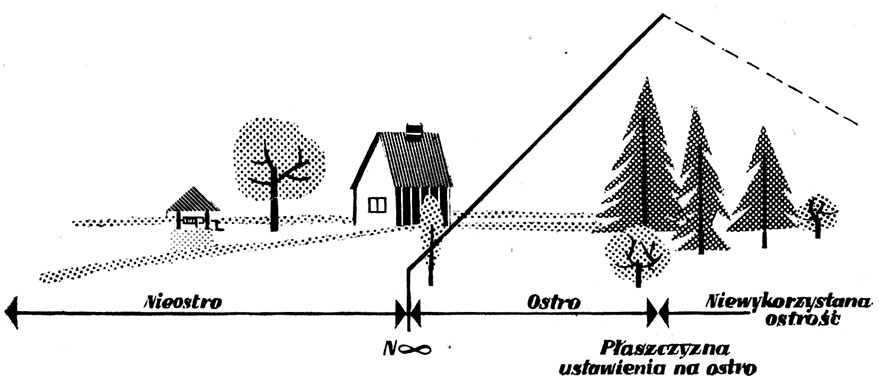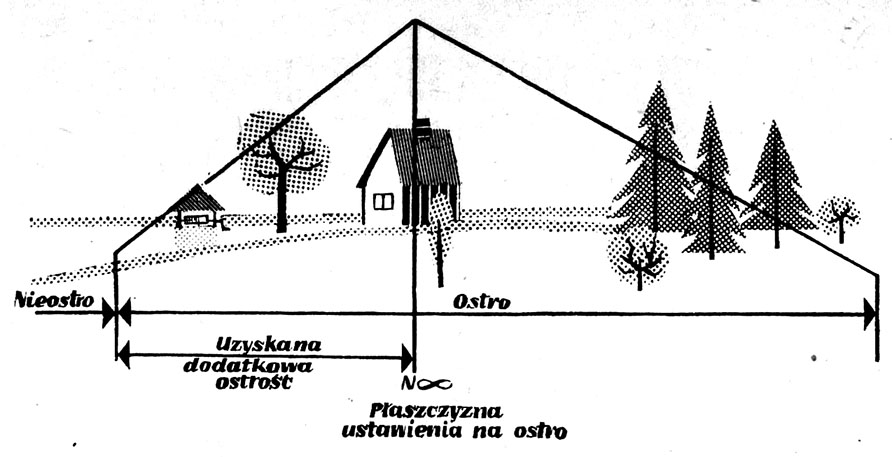If accept, that the maximum allowable unsharpness (i.e. the diameter of the bright disc) should be the highest 1/3000 diagonal size of the photo, then for each lens and for each aperture you can find such a focus distance, at which images of very distant objects (at least about 3000 focal lengths) they will be just as sharp, and objects much closer. The limit of this proximity depends on the focal length and the relative aperture. These objects are described as "sharp”, because the diameter of the bright disc of scattering, amounting to 1/300 part of the diagonal of the photo format, it presents itself to our eye as a point, not as a disc. This size is marked. not a fixed number, but a relative number, because images taken with a short focal length lens are generally smaller than images taken with a long focal length lens. Therefore, they are viewed from a shorter distance, which in turn requires more focus.
If an image the size of a postcard, taken with a camera with a focal length lens 150 mm, viewed from a convenient distance (ok. 25 cm), it will feel sharp if it is, that points will be rendered on it in the form of scattering circles with a diameter not larger than, for example,. 1/3000 part of the diagonal of the photo format, and so 150 mm : 3000 — 0,05 mm.
You have to remember when taking photos, that the sharpness decreases as you move away from the focusing plane, but decreases much faster towards the camera than vice versa. This is why, if we want to make the most of the focus zone using the largest aperture, focus the lens sharply on the main subject, but about two-thirds of the distance between the lens and the subject (counting from the camera towards the subject). Then, when setting the required aperture diameter, we will get a sharp image of the entire space between the photographed object, on which the focus has been placed, and further. Also in front of this space is a certain zone, where the image is still sharp enough.
Centering the position of the lens to obtain sharp images of several objects, at different distances from the camera, gives good results.
Therefore, apart from panoramic shots, it is almost never necessary to focus the lens to infinity, because then the depth of field is not used beyond infinity.
The area from the camera to the point, where the focus zone begins, stretching to infinity, is called the hyperfocal distance. If instead of infinity we focus the lens on a point located at the hyperfocal distance, it will turn out, that we will get sharp images not only of objects beyond the hyperfocal distance, but also closer, more than half the hyperfocal distance from the lens.

Drawing. Depth of field when set to infinity.
The figures show the differences in depth of field at infinity and hyperfocal distance . In the picture above, "infinity” it starts on the second tree, and the sharpness extends to the middle of the house; in the picture below, the sharp focus is shifted to the cottage, therefore, objects farther away are as sharp as in the previous figure, but, moreover, the zone of focus has moved forward and reaches as far as the well. In this way, without losing any of the sharpness of very distant objects (in infinity), we will get an additional focus zone closer to the lens.

Drawing. Depth of field when set to hyperfocal distance.
The hyperfocal distance depends on the focal length of the lens and the aperture used. It can be calculated using the formula:

Where: h = hyperfocal distance,
f = focal length,
K = aperture,
c = diameter of the circle of scattering.